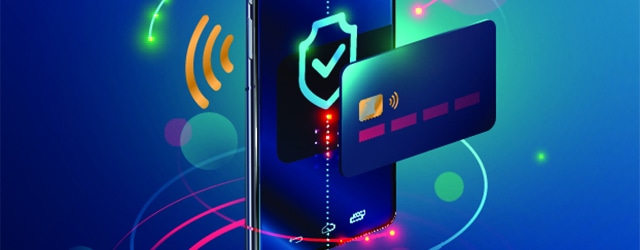Digital innovations have utterly transformed payments, making every choice more personal—and more mobile.

While reports of the demise of cash may be exaggerated, many businesses and consumers clearly enjoy the convenience of mobile and other digital forms of payment. According to Worldpay’s 2018 Global Payments Report, e-commerce will surpass $4.6 trillion globally by 2022, while the UNCTAD predicts mobile payments will exceed credit card payments in the developed world this year.
Mobile cash is catching on in the world’s less-advanced economies, in some cases leapfrogging traditional banking as unbanked citizens increasingly use phones to connect to the digital economy. In the developing world, banks are offering phone-operated money-transfer and mobile wallets, facilitated by real-time payment trackers and distributed ledger technology (DLT). Coupled with new digital assistants and chatbots, these developments represent a vast change in individuals’ relationship with their financial institutions. As these changes take hold among customers, they force banks, in turn, to rethink how they innovate.
When Kenya’s largest mobile operator, Safaricom, launched M-Pesa with Vodacom in 2007, it quickly morphed from a microloan repayment service into a money-transfer scheme by repurposing the user’s SIM card and phone account into a bank account for virtual currency. This somewhat accidental discovery is fast becoming a global phenomenon. According to the Global Acceptance Transaction Engine (GATE) Mobile Wallet Trends Annual Report, 2.07 billion consumers worldwide will use a mobile wallet to make a purchase in 2019, up nearly 30% from the 1.6 billion consumers recorded at the end of 2017.
According to The Next Phase of Digital Wallet Adoption, a Forrester report commissioned by JPMorgan Chase, features that encourage respondents to use digital wallets over other payment methods include order-ahead-and-pay, coupon/reward redemption, and self-service pay-at-table. Such features are usually only available within single-store apps or limited restaurant partnerships, although they are included in the leading global wallets—Apple Pay, Android Pay, and Samsung Pay. A killer wallet app would provide a full range of these features and, perhaps most important, include a large range of providers, avoiding the need for multiple apps.
Millennium IZI, the mobile banking solution of Millenium BIM, one of Mozambique’s largest banks, enables customers to perform most financial transactions on their mobile phones. It recently offered interoperability with M-Pesa, Vodafone’s mobile phone–based money transfer service, financing and microfinancing service; the tie-up resulted in over one million transactions between the two platforms in the first few months after launch.
Since unveiling its mobile wallet, payit, in February of last year, First Abu Dhabi Bank has used it to promote financial inclusion. In addition to allowing expatriates from the United Arab Emirates to send cash back home, users can send money to friends, pay bills, split bills and shop online. Payit also allows them to make purchases in stores via sound-wave technology. This is especially handy for merchants, as it allows them to accept payments using regular cash registers and doesn’t require them to install new hardware.
Last year, Moldova’s Moldindconbank allowed customers to withdraw and add cash to a card account using a mobile phone by adding scanning devices to its ATMs. By sending a barcode image generated in the mobile app to another party, the customer can enable that person withdraw cash by scanning the image on their smartphone.
In Pakistan, Telenor Microfinance Bank, in partnership with Valyou Malaysia, is spearheading an international remittance wallet, powered by Alipay’s blockchain technology. Unlike the previous wire-based remittance services, this one can save money by cutting out intermediaries and time, as transactions take seconds. Telenor claims the new mobile wallet improves transparency, thereby nurturing greater customer confidence in Pakistan’s macroeconomic stability.
Creating Confidence
Underpinning the shift to mobile cash is the adoption of real-time payments trackers. Since launching a corporate real-time tracker in April 2018, the UAE’s Mashreq Bank has experienced a 64% reduction in calls to its customer-service unit for payment inquiries, and a 77% increase in the number of searches on the payment tracker.
To provide greater transparency around the movement of funds and reduce inquiry volumes, the National Bank of Kuwait (NBK) leveraged the unique end-to-end transaction reference (UETR) required to identify transactions across national borders, introduced by SWIFT through the launch of the global payment innovation (GPI) platform. NBK integrated the UETR with the NBK customer portal using an application program interface (API) for fetching transaction-related information from SWIFT GPI and feeding this information into its customer portal. Prior to the launch of the service, clients couldn’t track the date and time of funds settlement to the final beneficiary.
Many see GPI as the correspondent banking industry’s response to the disruptive forces of blockchain, and the solution to some of the transparency and tracking issues that have traditionally plagued payments. But banks are no longer tied to their own in-house service offerings; like their customers, they can shop around for the solutions that best match specific clients needs. Thus, many banks are offering both GPI and the Ripple blockchain to give customers greater choice and align themselves with the new reality of banking as a service (BaaS). After introducing the GPI tracking initiative, NBK saw the number of queries drop 60%, but it sees Ripple as necessary to meet the specific needs of expatriates working in Kuwait who previously relied on money-transfer agencies to send cash home.
Digital ledger technology, in which transactions are recorded in multiple places at the same time, further facilitates and builds confidence in digital payments security, since details are verifiable. In Russia, Alfa Bank’s first exposure to DLT was as a user of Ethereum’s blockchain technology. In 2018, it migrated to Hyperledger Fabric to provide real-time airline ticket payments for corporate agents of S7 Airlines, Russia’s largest domestic carrier. Previously, agents could only purchase tickets against a bank guarantee—which usually meant 100% cash covered—or by payments in advance, usually with significant excess to ensure that future needs were covered. Now, customers are released from bank guarantees, advances are returned and pay-as-you-order transactions are the rule. Its flexible approach to technology puts Alfa in a position to scale the solution for other business cases.
Similarly, Nuggets, an e-commerce payments and identification platform, leverages blockchain technology to ensure that end users are in full control of their data, offering users a digital vault that they can access for payments, logins and ID verification.
Next Up: Applying AI to Payments
The next step, say bankers, is to move from making the mechanics of payments mobile to making them simpler as well. From there, it becomes easier to offer advice in a mobile setting. China Guangfa Bank, for example, developed CGB HuiPay to simplify payment processes by applying artificial intelligence and machine learning on various payment decisions to provide smarter, personalized experiences for every client.
User experience also lies behind DBS Bank’s corporate chatbot, Joy. Although readily available for retail banking customers, Joy was Asia’s first corporate virtual assistant. It enables DBS to address multiple customer inquiries at once, minimizing wait times, and is available 24/7.
While convenience is eroding consumer skepticism, mobile payments are still far from being universally accepted. Almost 90% of US consumers prefer to pay by cash, credit card or debit card over mobile alternatives, despite the fact that 77% of the population own a smartphone, according to Simon-Kucher & Partners. Mobile payments, whether through an app or a wallet, are safer than cards in at least one respect: Merchants don’t receive the customer’s account or card details—only a unique, one-time code. Yet respondents cited confidence (70%) and security concerns (40%) as the biggest barriers to mobile payment adoption.
This lingering confidence gap underscores the need for banks to emphasize creativity and flexibility if they want to retain customers and win new ones. The days of one-size-fits-all payments are over; the banks making the most of the new era of digital cash are the ones that are embracing the power of personalization and collaboration.
Payments Innovators 2019 |
|
|---|---|
Company |
Innovation |
| Alfa Bank | Public Utilities Payments Monitoring and Control |
| China Guangfa Bank | CGB HuiPay |
| DBS | JOY Chatbot |
| First Abu Dhabi Bank (FAB) | Payit |
| Mashreq | Corporate Real-time Payments Tracker |
| Millenium bim Mozambique | Millennium IZI interoperability |
| Moldindconbank | Mobile Cash |
| National Bank of Kuwait (NBK) | Real Time End-To-End Payment Tracking on Customer Payments |
| Nuggets | Nuggets |
| Telenor Microfinance Bank | Blockchain International Remittance Wallet |



